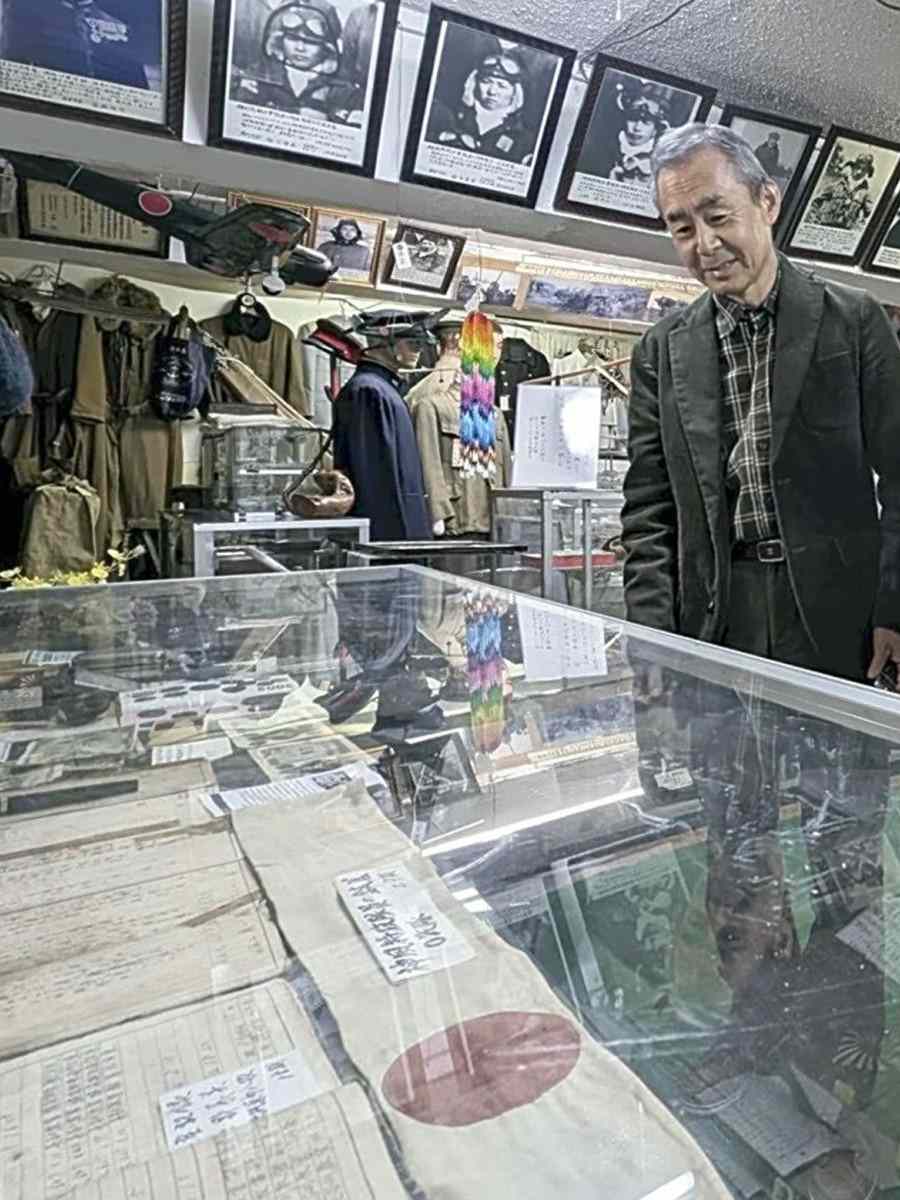
Takayasu Kawano looks at items on display at the Yokaren Shiryokan archive museum in Oita City on Nov. 15.
14:13 JST, December 25, 2023
OITA — An archive museum exhibiting items left behind by pilots who died on kamikaze attack missions during the Pacific War will close down in August 2024, three years after the death of its founder, who was a kamikaze pilot during the war.
The museum’s collection of about 3,000 artifacts will be donated to Oita City’s Gokoku Shrine, which is one of the Gokoku shrines nationwide, dedicated to those who died for the country.
The museum, Yokaren Shiryokan, opened in 1988. Yokaren means naval aviator trainees in the former Imperial Japanese Navy and late in the war, they were trained as kamikaze pilots. Shiryokan means archive museum.
Kiichi Kawano, who founded the museum and died in 2021 at the age of 95, renovated his home to house the museum.
The museum is currently run by his son Takayasu, 68.
Kawano was born in Hasama, which is now a part of Yufu, Oita Prefecture. After graduating from a national school, he joined the yokaren. In July 1945, as the war situation worsened for Japan, he joined the kamikaze attack unit at Kisarazu Naval Air Group in Chiba Prefecture.
Kawano exchanged uniforms with another member of the unit before the latter went on his attack mission. He told Kawano that he would be waiting for him in the ocean and was later killed in action.
On Aug. 15, 1945, just before his own mission, the Emperor announced Japan’s defeat.
“I failed to die,” Kawano thought and returned home disappointed.
After the war, he began working part-time for the prefectural police before setting up a real estate business.
Kawano came up with the idea to establish a museum after visiting Yushokan archive museum, which displays artifacts that belonged to yokaren trainees, in Ami, Ibaraki Prefecture, in 1985. He wanted to create a space to commemorate those who had given their lives for the country at such a young age by displaying items those pilots left behind.
Kawano opened the museum on Aug. 14, 1988, at the age of 62 in a renovated section of his house. He had stopped working so he could focus on conveying the horrors of war.
Initially, the museum only exhibited items and photos related to his wartime comrades. However, the collection grew as Kawano received similar items from all over the country.
Every year, several hundred visitors from around Japan would come to the museum. Since Kawano’s death, his son, who lives elsewhere in the city, has taken charge of responding to those who make bookings to visit on their website.
However, his son has realized that it has become difficult to manage the museum’s valuable collection, which includes farewell letters written by the kamikaze pilots. With no one willing to take over, the younger Kawano decided to close the museum in 2024, a year before the 80th anniversary of the end of World War II.
He spoke with the local Gokoku Shrine, and the shrine said it would accept the collection.
“I hope the museum’s collection, which is filled with the wishes and souls of many people, will continue to be used with care,” said Soei Hirata, head of the Toyo-no-kuni Usa-shi Juku, a citizens’ group in Usa in the prefecture.
Hirata, who is an Usa Naval Air Group researcher, visited the museum in November.
The Gokoku Shrine is planning to set up an area to display the items from the collection. Some items from the museum have already been moved to the shrine.
“By exhibiting the collection, I hope people will realize that Japan was built on the tragic loss of many lives,” said Hidefumi Yasaka, 62, the shrine’s chief priest.
The museum is scheduled to hold a closing ceremony around late May 2024 and officially close on Aug. 14, the same day as its opening in 1988. Visitors will be able to visit the museum through May.
“I would be grateful if my father’s wishes could be passed on to future generations,” Takayasu said.
Others forced to close
More and more private archive museums exhibiting such items have closed, mostly because those running the facility are aging, and the facilities that are still open are finding it difficult to remain so.
In addition to the Yokaren Shiryokan museum in Oita City, the privately run Okayama Kushu Shiryo Center, which focused on the Okayama air raid, closed in 2017.
In Kitakyushu, the Kitakyushu Heiwa Shiryokan, which was run by a citizens’ group, closed in 2022 following the opening of the Kitakyushu City Museum of Peace, which is run by the city. The citizens’ group museum was also having difficulty maintaining the artifacts.
Yoshiko Komatsu, 55, a former employee of the closed museum, took over the collection and opened Kitakyushu Heiwa Shiryoshitsu Tico Place in June.
Komatsu said the advantages of having a private facility is that “the thoughts of the exhibitors can be directly conveyed to the visitors.”
She added that running the facility is very challenging and that “there is a serious shortage of manpower.”
"Society" POPULAR ARTICLE
-

M4.9 Earthquake Hits Tokyo, Neighboring Prefectures
-

M7.5 Earthquake Hits Northern Japan; Tsunami Waves Observed in Hokkaido, Aomori and Iwate Prefectures
-

Tsukiji Market Urges Tourists to Avoid Visiting in Year-End
-

Israeli Tourists Refused Accommodation at Hotel in Japan’s Nagano Pref., Prompting Protest by Israeli Embassy and Probe by Prefecture
-

M5.7 Earthquake Hits Japan’s Kumamoto Pref., Measuring Upper 5 Intensity, No Tsunami Expected
JN ACCESS RANKING
-

Keidanren Chairman Yoshinobu Tsutsui Visits Kashiwazaki-Kariwa Nuclear Power Plant; Inspects New Emergency Safety System
-

Imports of Rare Earths from China Facing Delays, May Be Caused by Deterioration of Japan-China Relations
-

University of Tokyo Professor Discusses Japanese Economic Security in Interview Ahead of Forum
-

Japan Pulls out of Vietnam Nuclear Project, Complicating Hanoi’s Power Plans
-

Govt Aims to Expand NISA Program Lineup, Abolish Age Restriction






















